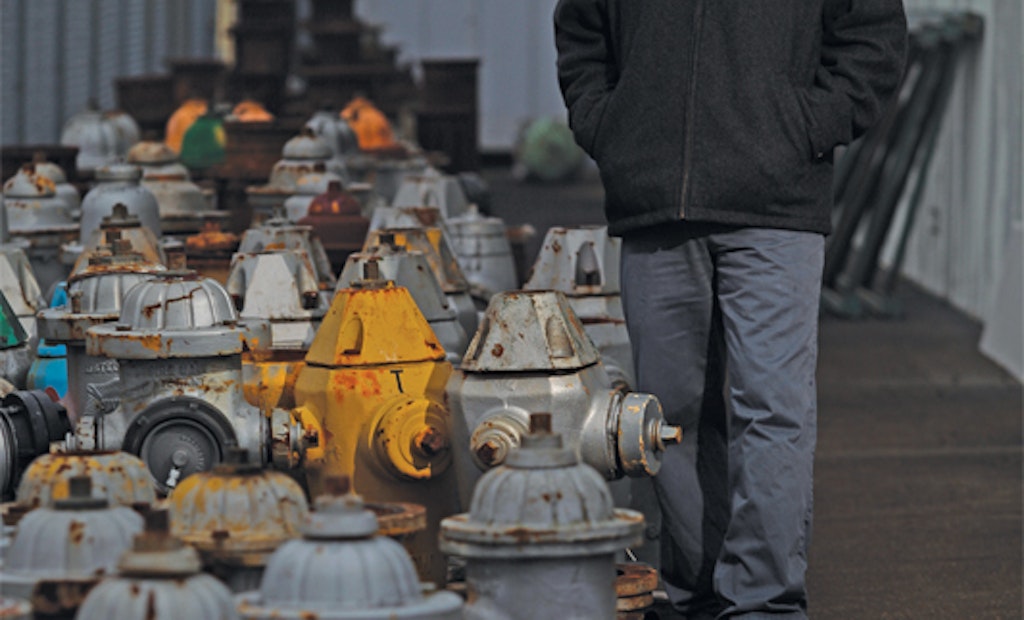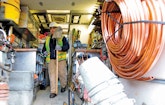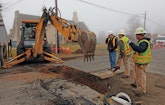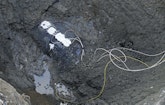
Interested in Inspection?
Get Inspection articles, news and videos right in your inbox! Sign up now.
Inspection + Get AlertsSpend some time around Tacoma Water, and you might not hear the word “maintenance” very much.
It’s not that the utility serving the city of Tacoma and surrounding communities in Washington state doesn’t care about keeping up its infrastructure. Just the opposite. At Tacoma Water, they’re a lot more likely to talk about “asset management.”
That’s not just a fancy term meaning the same thing. Asset management means thinking a lot bigger. Tacoma Water defines it this way: “An integrated set of processes to minimize the life cycle costs of owning, operating and maintaining assets at an acceptable level of risk, while continuously delivering established levels of service.”
“It’s looking at, what does it cost to take care of your existing infrastructure and maintain it,” explains Seth Doull, a Tacoma Water engineer. The utility, which replaces about 10 miles of main a year on average, focuses on getting the most value for its dollar.
“It’s not the cheapest material you put in the ground, it’s the most cost-effective, when looked at over the entire life cycle of the asset,” Doull continues. Deciding on a prospective repair doesn’t just require evaluating the chances of system failure – it also demands considering what the consequences of failure would be.
Through it all, the ultimate goal is to give top-notch service to the water system’s customers.
It’s a delicate balance, says Shannon Rauch, Tacoma Water’s asset management supervisor. “There’s the cost of operating the system, the risk you take on if you’re minimizing those costs, and the level of service your customers expect to receive from you.” The end goal, she continues, is “making sure you’re minimizing the cost, but not taking on too much risk, and making sure customers are getting the service they’re expecting.”
Century-old system
Located on Puget Sound, halfway between Seattle and the Washington state capital of Olympia, Tacoma is a city of just under 200,000 people. Tacoma Water is supplied by the Green River, and its resources are plentiful.
“We’re long on water,” says Tony Lindgren, distribution engineering manager for the utility. “We have an average daily demand of 55 million gallons, and a supply of upwards of 100 mgd to serve that.”
The supply is mainly gravity-fed, bolstered by a system of backup wells, says Ray West, the distribution operations manager. The lion’s share of customers are residential, accounting for just over 90,000 of the utility’s 97,500 connections; the rest are industrial and commercial customers. One in particular, the paper producer Simpson Tacoma Kraft Co., accounts for about one-third of the utility’s daily water demand.
Tacoma Water also has a new $185 million filtration facility under construction. “That’s a very significant project for us,” says Rauch. “Up to this point we were unfiltered” – one of only a very few unfiltered water utilities in the country.
Tacoma’s water main system is more than 100 years old and includes pipe composed of a wide range of materials. Among those are asbestos cement and cast iron, but there’s a growing amount of ductile iron. “That is our material of choice to install now,” Lindgren says. Durability is one major reason: “We’re trying to design for 100-plus years,” says West.
Over the years the utility has grown appreciably by acquiring smaller systems in surrounding communities, some up to 30 miles away. The added systems have often used materials below Tacoma’s standards, requiring replacement.
“We’re pretty conservative on the type of materials we use,” West says. “Once it’s in the ground, we want it to last a long time.”
Strategic planning
Guided by earlier strategic planning, Tacoma launched a major program in 2005 of systematically replacing deteriorated water mains. The program included consistently budgeting for the work from year to year.
The initial focus was on water mains with a history of frequent breaks and those that were among the older lines in the system, as well as the type of main involved.
“We knew certain types of cast iron were performing poorly,” says Doull. “We went out for some of the oldest ones.” Galvanized pipe, which suffered from internal corrosion, was also targeted, he adds. “We replaced almost all of that.”
But Tacoma Water quickly raised its sights. In 2008 the utility took part in an international study benchmarking 15 municipal water supply operations on their asset-management processes. The study was conducted by the International Water Association and the Water Services Association of Australia.
Each participating utility, including Tacoma, got a report summarizing strengths, recommending improvements, and ranking all the participants in various asset-management elements.
“We were told we had a good system, a good plan, but it wasn’t formalized in any way,” says West. Still, Tacoma was off to a good start, with something to build on. So, in 2010, the utility took the next step, creating a formal asset-management program.
Risk-based approach
“We’ve really tried to take a more risk-based approach to planning for replacement,” says Rauch, who joined the utility in 2010. Having gotten “the low hanging fruit” in the preceding years, she continues, “now we have the luxury of stepping back and figuring out where we’re going to get the best return for our money for main replacement.”
With the new approach, Tacoma Water is moving away from focusing so much on how old the pipe is. “Age isn’t a reliable predictor of condition,” Doull points out. Downtown Tacoma boasts some of the system’s oldest pipe, most of it cast iron, yet it remains sound despite its age, he explains. “We’ve decided to leave those alone.”
Asset management requires a more comprehensive and analytical approach to the data about the system, Rauch explains. And “risk-based” means looking at more than just the conditions of the pipe being considered for repair or replacement. It entails understanding what could happen if it fails.
Teams of employees called Strategic Asset Management Plan work groups – or SAMP teams for short – evaluate each of the utility’s assets using a series of consistent criteria to identify both the likelihood and consequence of failure.
Wealth of data
Previous leaders at the utility had the foresight to collect a wealth of data over the decades. “We have data going back 30 years,” says Doull. Using that data, Tacoma Water was able to develop an economic model based on those three decades of break history and “about 10 years of pretty good cost data” for repairs.
For instance, for a small-diameter main breaking in a residential area, the consequence of failure could be fairly small and repair is easy and relatively inexpensive – perhaps $5,000 or $10,000, Doull says.
But for a larger transmission main buried under a main street or major highway, the cost of a repair or replacement could skyrocket. So does the inconvenience posed to the general public when a road has to be shut down and torn up for days or weeks to complete the repair.
Repairs where soil has been contaminated from industrial sources are sure to be a lot more expensive because of the extra care required. And a main failure that could affect major institutions, such as a school or a hospital, likewise carries far greater consequences.
“We are now beginning to better understand what our highest-risk assets are,” says Rauch. Managing them effectively requires asking whether there is sufficient backup infrastructure that can be brought online if the primary infrastructure fails, and whether there is an appropriate replacement project protocol for a certain piece of equipment or a certain process.
Thinking ahead also allows for more choices in solutions. “Maybe it’s as simple as adding a valve or another feed into a hospital or school, and not necessarily having to replace the main,” says Rauch.
Getting a more complete picture of the condition of every asset is also part of the approach. Tacoma Water began a condition assessment project a few years ago, and it’s still underway. Already crews have found that some proposed replacement projects weren’t necessary.
“They did their investigation and the main was in good shape,” says Doull. The money that would have been spent on those unneeded replacements can now be directed elsewhere.
Analytical tools
Asset management is a kind of toolkit, says Rauch, and the “tools” are particular analytical frames and techniques that can be applied to answer questions and understand situations.
One such tool is making a business case in order to evaluate a prospective action. At Tacoma Water, says West, major capital improvement projects now must undergo a business-case evaluation. Rauch says that illustrates how the utility is working to teach everyone in the operation how to “apply asset-management principles in the job they do.”
Asset management is about more than just money and cost. “Asset management provides us with the information in order to make informed decisions,” Lindgren says.
It’s not rigid, either. Every budget biennium, using the asset-management criteria, Tacoma Water develops “a list of projects that make the most sense for us,” Lindgren says. “But that may change, depending on what comes up.”
For instance, if the city has put rebuilding a certain street on the fast track, and that location is earmarked for a future water main project, Tacoma Water could decide to move that project up so that it can be completed while the street is torn up, avoiding repeated disruption to traffic.
It’s not enough just to consider the economics of a project. “There are a lot of social impacts that we need to look at,” Lindgren says.
Team approach
The focus on asset management has also helped encourage much more collaboration between various departments and divisions of the utility, Doull notes. It also has promoted two-way communication between management and the front-line employees.
“When I first started with asset management, what I saw was the top-down and bottom-up approach,” he says. It isn’t enough for management just to communicate information down to the rest of the staff. “We also learned how important it was to get information from the staff people who have their hands on the equipment.”
The SAMP teams illustrate that approach. Made up of six or seven employees each from across the staff, representing a range of trades and professions, each of the 15 teams is assigned to one of Tacoma Water’s 15 asset classes: Water meters and distribution mains, services and transmission mains, pump stations, and so on.
“It’s a very focused effort to look at a particular asset class,” says Doull. After six months to a year of biweekly or monthly meetings, collecting all the information that the utility has about the assets to which a team is assigned, the teams then reconvene as needed when confronted with relevant decisions, such as whether to begin using a new kind of meter.
“It’s vital to have the input from our operational staff and mechanics,” Doull says. “They’re the ones that touch these materials. Without that perspective, we wouldn’t be as successful as we are.”
A history of vision
Tacoma Water employs strategic planning in every facet of its operation, not just its approach to asset management. Besides its retail water business, the utility also is a wholesale provider of water to neighboring utilities. The growth of that segment of its revenues has been a direct product of strategic planning, Doull says.
As a relative newcomer to Tacoma Water, Rauch finds the operation’s commitment to strategic planning to be in keeping with a long tradition of forward thinking at the utility going back to its founding.
The foresight to start detailed data collection three decades ago and the decision in the early 2000s to become more intentional and systematic about keeping the system upgraded continued that spirit. The current use of tools such as strategic planning and asset-management represent its latest expression.
Building the system a century ago “took some vision and forethought,” says Rauch. “I still believe that’s ongoing in our long-range planning. We have a strong team here.”











